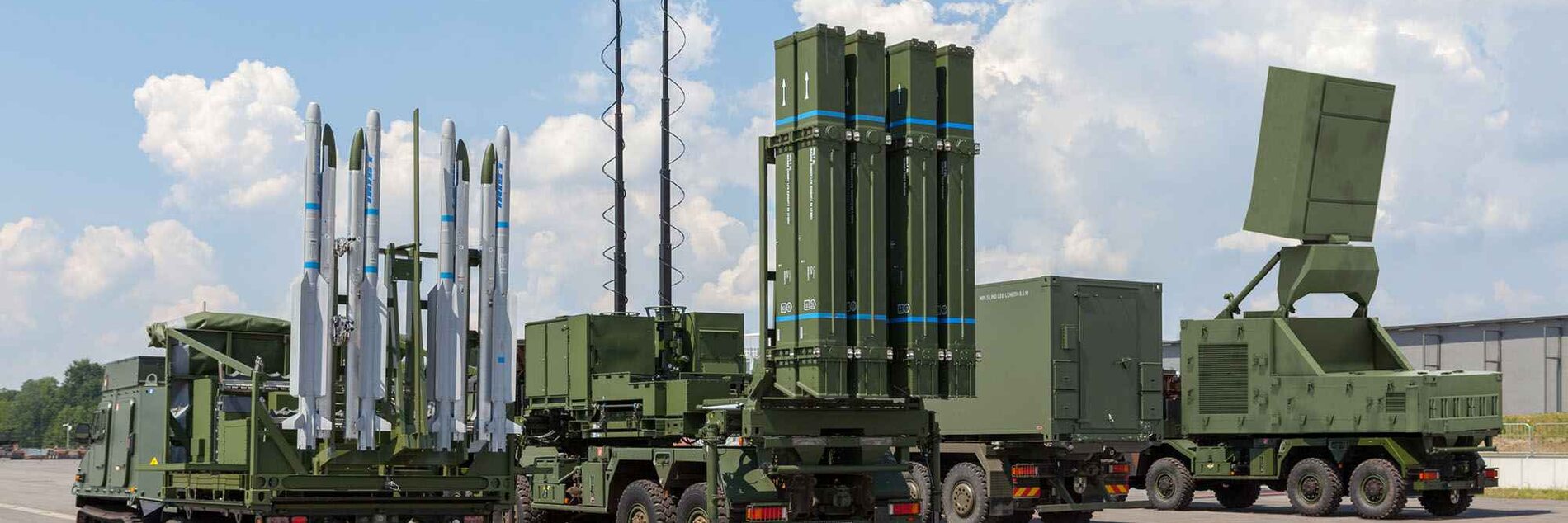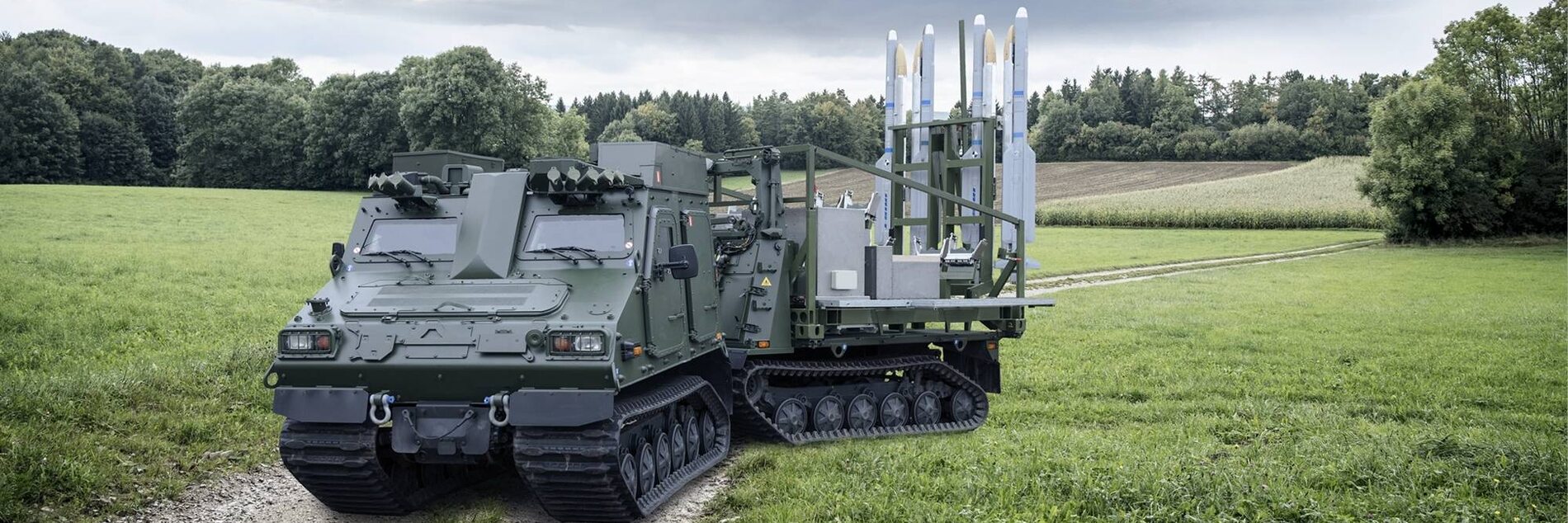Reacting to the massive barrage of missiles and drones on Ukrainian cities, Germany’s defense minister said the first of four promised IRIS-T SLM surface-to-air missile systems will arrive in Ukraine over “the next few days.”
After this morning’s events, it couldn’t come soon enough.
“The renewed rocket fire on Kyiv and the many other cities makes it clear how important it is to deliver air defense systems to Ukraine quickly,” German Defense Minister Christine Lambrecht said in a statement. “Russia’s missile and drone attacks primarily terrorize the civilian population. That is why we are now supporting them with anti-aircraft weapons in particular. In the next few days, the first of four state-of-the-art ones will be up to effectively protect the people of Ukraine.”
Manufacturer Diehl Defence says the ground-launched IRIS-T SLM guided missile at the heart of the system can hit targets up to about 25 miles away at altitudes of up to more than about 12 miles. This can provide short-to-medium area air defense around critical locations like major population centers. That would add much-needed capabilities to an aging Soviet-era air defense arsenal Ukraine has already used to great effect to prevent Russia from achieving air superiority. You can read much more about these systems in our initial report that Germany was considering sending examples to Ukraine.

Back in June, Chancellor Olaf Scholz announced that IRIS-T SLM systems, its most modern air defense system, would be sent to Ukraine.
“The government has decided to deliver the IRIS-T system, the most modern air defense system Germany has,” Scholz said in a speech to the German parliament, according to a translation by the German news site DW. “This will enable the Ukrainian government to defend entire cities from Russian missile attacks.”

The IRIS-T SL missiles can also be used in newer iterations of the National Advanced Surface-to-Air Missile System, or NASAMS, along with the AMRAAM-ER (for Extended Range) missile. The latter weapon adds the motor from another Raytheon product, the RIM-162 Evolved Sea Sparrow Missile (ESSM), to the AIM-120C-7 warhead and seeker. NASAMS’ base missile is the AIM-120 AMRAAM — the exact same as those fired from fighter aircraft. Having AMRAAM as one of its missile options means that, potentially, countries from across NATO and elsewhere could provide AIM-120s to Ukraine from their own stocks, especially the older AIM-120A/B models. Additionally, NASAMS can now be armed with the shorter-range AIM-9X Sidewinder missile. Regardless, IRIS-T SLM and NASAMS are both uniquely capable of tackling the cruise missile threat, but there are still limitations that you can read about in the Twitter thread below.
While Germany has been criticized for not providing enough arms to Ukraine fast enough, especially when it comes to Ukraine’s unanswered pleas for the country to approve the transfer of Leopard 1 or 2-series tanks, it has still provided a significant amount of weaponry, the Oryx OSINT research group noted. “Contrary to popular perception, Germany has delivered significant amounts of arms and equipment to Ukraine to aid the country in its fight against the Russian military,” Oryx’s Stijn Mitzer and Joost Oliemans wrote in an assessment last month.
According to Oryx, German materiel support already delivered to Ukraine includes 30 Gepard self-propelled anti-aircraft guns, three MARS II multiple rocket launchers (a Germany-specific derivative of the M270 Multiple Launch Rocket System, or MLRS), 10 155mm PzH 2000 self-propelled howitzers along with guided artillery rounds, 3,200 Stinger and Strela man-portable air-defense systems (MANPADS), close to 10,000 Panzerfaust 3 and RWG 90 MATADOR infantry anti-tank weapons.
In addition, Germany has provided Ukraine with “hundreds of vehicles, nearly 22 million rounds of ammunition and a plethora of other equipment including 28,000 helmets and MiG-29 Fulcrum fighter jet spare parts. These deliveries are soon to be followed by a further four PzH 2000s and two M270s [MARS II], four IRIS-T SLM SAM batteries, 20 laser-guided rocket systems, 43 reconnaissance UAVs and up to 20 unmanned ships,” Oryx noted. “Berlin also contributed at least €2 billion ($1.94 billion) to Ukraine’s security capacity building fund with which the Ukrainian government can purchase armament from other countries, including a further 100 PzH 2000s and 18 RCH-155 SPGs from German arms manufacturer Krauss-Maffei Wegmann.”
Germany may have a bit of extra motivation after Monday’s attacks. It seems its consulate in Kyiv was hit.
Before we head into more of the latest news from Ukraine, The War Zone readers can catch up on our previous rolling coverage here.
The Latest
In the wake of his country’s massive missile and drone attack on Kyiv Monday morning, Putin went on Russian television to say they were a warning against Ukraine carrying out future attacks like the one on the Kerch Bridge, which he called “acts of terrorism.”
Deputy Head of the Security Council of the Russian Federation Dmitry Medvedev announced the need for a “complete dismantling” of the political regime of Ukraine, which poses a “direct threat to Russia.”
“The Ukrainian state in its current configuration with the Nazi political regime will pose a constant, direct and clear threat to Russia. Therefore, in addition to protecting our people and protecting the country’s borders, the goal of our future actions, in my opinion, should be the complete dismantling of the political regime of Ukraine,” the politician wrote, according to Russian state media outlet TASS.
In its latest update, the Ukrainian General Staff reported that there were an as-yet unknown number of civilians killed in Russian missile and drone attacks that hit more than 20 cities and towns.
“In the course of a day, the occupiers launched more than 84 missile and air strikes. The enemy used air, sea and land-based cruise missiles, ballistic missiles, anti-aircraft guided missiles, and reconnaissance and attack UAVs of the [Iranian-designed] ‘Shahed-136″ type.'”
Ukrainian officials maintain they shot down about half of those, but The War Zone could not independently verify those figures.
Ukrainian President Volodymyr Zelensky remained defiant, addressing the attacks from Kyiv.
“Restoration work is currently underway across the country,” said Zelensky. “We will restore all objects that were damaged by today’s attack by Russian terrorists. It’s only a matter of time. I thank our Air Force and Ground Forces units that were involved today! Ukraine cannot be intimidated.”
The attacks hit a number of energy plants across Ukraine, so the government called on residents to conserve electricity. Most of the western city of Lviv, for instance, is without electricity.
Still, like their president, Lviv residents remained unbowed.
And while these attacks were revenge for the conflagration on Putin’s prized Kerch Bridge, a pedestrian span in Ukraine’s capital remained intact, despite a missile making a direct hit underneath it — an apparent narrow miss.
A video captured of one of the cruise missiles hitting Kyiv shows just how it pops up and dives during the terminal phase of its attack
While there have been a number of deaths resulting from this attack, some people – like these motorists in Dnipro – just barely managed to miss serious injury.
Speaking of lucky, this shot by a Ukrainian soldier with what appears to be an Igla MANPADS, which is claimed to have brought down a Russian cruise missile, could certainly qualify. At present, The War Zone cannot verify what the soldier actually hit beyond the basic claims that are circulating.
Today’s Russian cruise missile barrage was widely condemned by world leaders, including U.S. President Joe Biden, who said the attacks “killed and injured civilians and destroyed targets with no military purpose.”
Separately, Ukrainian Defense Minister Oleksii Reznikov once again urged Russian troops, who he said will be remembered as ‘thieves, rapists and murderers,” to surrender.
To that end, Zelensky said on his Telegram channel that he had “a productive conversation” with Biden. “The main topic of discussion was air defense. Currently, this is the number 1 priority in our defense cooperation.”
In an official White House readout of that conversation, Biden talked about providing Ukraine “advanced air defense systems.” There were no additional details mentioned about those systems in that readout.
Similar assistance, so far, has not come from Israel, something that reportedly does not sit well with the Kyiv government. Economist correspondent and author Anshel Pfeffer says unnamed Ukrainian officials have told him they wonder why that nation, a world leader in air defense systems, has not done more than offer some advice on countering Iranian drones.
Meanwhile, the condition of the affected train section on the Kerch Bridge, the attack on which spurred Putin’s vengeful response on Ukrainian civilians and power infrastructure, seems precarious at best.
Though Russia said the missile and drone attacks were in response to last week’s attack on the Kerch Bridge, Ukraine’s Defense Intelligence Directorate (GUR) said on its official Telegram channel that Russians have been planning “missile attacks on the Ukrainian capital and infrastructure ‘since the beginning of October.'”
“According to the military intelligence of Ukraine, the Russian occupying forces received instructions from the Kremlin to prepare massive missile attacks on the civilian infrastructure of Ukraine on October 2 and 3. The military units of the strategic and long-range aviation received orders to prepare for the task of massive missile attacks. The objects of critical civil infrastructure and central areas of densely populated Ukrainian cities were identified as targets.”
While there has been much focus on the aerial barrage on Ukrainian cities and towns in response to the bridge attack today, there is still a ferocious ground war going on.
Russia, “trying to hold the temporarily captured territories, is shelling the positions of our troops, is concentrating its efforts on attempts to disrupt the active actions of the Defense Forces in certain directions, and is conducting offensive actions in the Bakhmut and Avdiiv directions,” the Ukrainian Armed Forces General Staff said on its Telegram channel.
Russia’s Ministry of Defense however said Ukrainian forces “made unsuccessful attempts to cross the Zherebets River near Makeyevka and Raygorodok” near Lyman in Lugansk.
In its latest assessment, the Institute for The Study of War said Ukraine was still advancing.
ISW offered the following key takeaways:
- Ukrainian forces continued to advance east of the Oskil River in the direction of Luhansk Oblast and have entered Stel’makhivka (about 11 miles west of Svatove). Russian forces launched unsuccessful assaults on Burdaka on the Kharkiv Oblast-Russian border, and Terny northeast of Lyman.
- Russian sources reported that Russian forces attempted to attack in the direction of Ternovi Pody (approximately 19 miles northwest of Kherson City). Ukrainian sources reported that Russian forces continued to target newly liberated settlements in northern Kherson Oblast with artillery, MLRS, and aviation.
- Ukrainian sources reported that Ukrainian forces repelled over 30 attacks in the Bakhmut and Avdiivka areas. Russian forces launched an unsuccessful assault southwest of Donetsk City.
- Russian forces targeted residential areas of Zaporizhzhia City with cruise missiles.
- A Russian milblogger accused North Ossetia and Vladikavkaz of failing to fulfill mobilization orders due to carelessness and the personal interests of regional officials.
- Ukrainian sources reported that Russian occupation authorities are moving their families from Kherson Oblast to Crimea, and from Starobilsk to Luhansk City.
The U.K. Ministry of Defense offered its assessment as well, showing contested areas in the south and east of Ukraine.
Gruesome images are still emerging from the battlefields, as this video, purportedly of Russian troops stepping on a landmine, shows.
And the ongoing battle for Bakhmut in the Donetsk region remains a bloody slog.
Meanwhile, Ukraine continues to add to its collection of captured Russian weaponry, like this relatively rare KAMAZ-43269 “Vystrel” armored personnel carrier. The appearance of even rarer versions for the KAMAZ-43269, which are also known as BPM-97s, equipped with 30mm cannon-armed BM-30D turrets had prompted speculation last week that some kind of nuclear provocation might be imminent. So far, nothing concrete has emerged to substantiate those particular fears.
We will continue to update this story until we state otherwise.
Contact the author: howard@thewarzone.com
